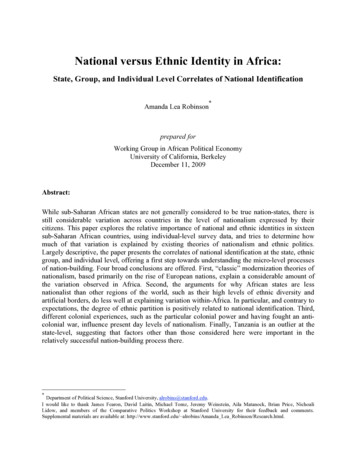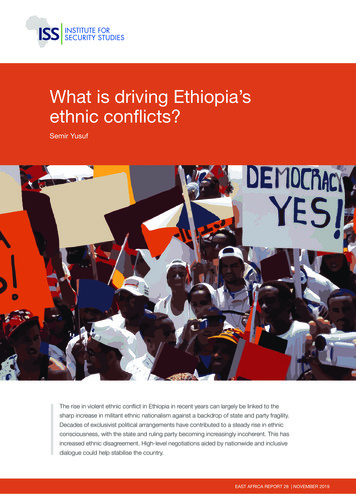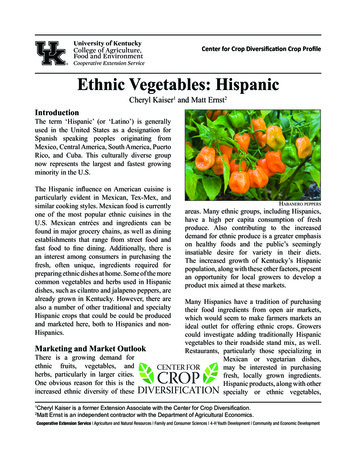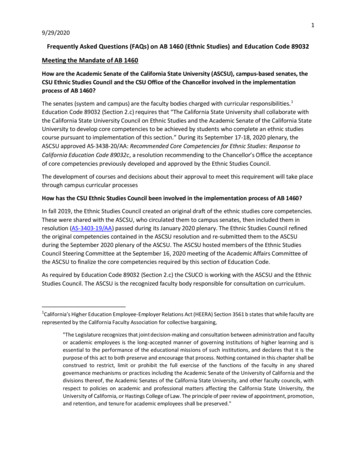National Versus Ethnic Identity In Africa
National versus Ethnic Identity in Africa:State, Group, and Individual Level Correlates of National Identification*Amanda Lea Robinsonprepared forWorking Group in African Political EconomyUniversity of California, BerkeleyDecember 11, 2009Abstract:While sub-Saharan African states are not generally considered to be true nation-states, there isstill considerable variation across countries in the level of nationalism expressed by theircitizens. This paper explores the relative importance of national and ethnic identities in sixteensub-Saharan African countries, using individual-level survey data, and tries to determine howmuch of that variation is explained by existing theories of nationalism and ethnic politics.Largely descriptive, the paper presents the correlates of national identification at the state, ethnicgroup, and individual level, offering a first step towards understanding the micro-level processesof nation-building. Four broad conclusions are offered. First, “classic” modernization theories ofnationalism, based primarily on the rise of European nations, explain a considerable amount ofthe variation observed in Africa. Second, the arguments for why African states are lessnationalist than other regions of the world, such as their high levels of ethnic diversity andartificial borders, do less well at explaining variation within-Africa. In particular, and contrary toexpectations, the degree of ethnic partition is positively related to national identification. Third,different colonial experiences, such as the particular colonial power and having fought an anticolonial war, influence present day levels of nationalism. Finally, Tanzania is an outlier at thestate-level, suggesting that factors other than those considered here were important in therelatively successful nation-building process there.*Department of Political Science, Stanford University, alrobins@stanford.edu.I would like to thank James Fearon, David Laitin, Michael Tomz, Jeremy Weinstein, Aila Matanock, Brian Price, NichoaliLidow, and members of the Comparative Politics Workshop at Stanford University for their feedback and comments.Supplemental materials are available at: http://www.stanford.edu/ alrobins/Amanda Lea Robinson/Research.html.
The nation-state is the primary mode of political organization in the international systemtoday. Based on the success of the nation-state in Europe, many thought it natural for postcolonial African leaders to attempt to culturally homogenize and build nations from the statesthat they inherited (Rothchild, 1983). However, with the possible exception of Tanzania, it isgenerally noted that post-colonial African states are not nation-states. Why not? A number oftheories have been given for this failure, but, to my knowledge, this is the first cross-sectionalempirical investigation of the plethora of conditions purported to thwart African nationalism. Tothe extent that some African states have partially succeeded in nationalizing their citizens to agreater degree than others, how well do classic theories of nationalism account for that success?The goal of this project is to take a first step towards answering these questions. Four broadfindings result: classic theories of nationalism explain a significant amount of variation acrossAfrica, theories that focus on qualities that are more common to African states than states fromother regions (e.g., high ethnic diversity) do less well at capturing variation within the continent,variation in colonial experience is related to present day levels of nationalism, and Tanzaniannationalism is not well explained by the theories tested here.This project makes three important contributions. First, it uses theories developed in boththe study of state nationalism and the literature on ethnic politics, to try to understand the choicebetween two potential group identities: ethnic and national. Second, it focuses the study ofnationalism on the African continent, where the states are relatively young and nationalism is notubiquitous. This yields interesting cross-country variation, and the possibility of studying theprocesses of nation-building as they are still occurring. Third, it uses individual level survey datafrom a representative sample of citizens across sixteen African countries. This is important, asnationalism – the widespread identification with the state – is fundamentally a massphenomenon. In most previous studies, especially historical accounts of the rise of nationalism inEurope, non-elite perspectives have been very rare (Conner, 1990). Thus, analyses of theseindividual level survey data from “not yet nation-states” make a significant contribution towardsunderstanding the causes of national identification.The main goal of this project is to determine how much variation in African nationalismis explained by existing theories of nationalism. Building on theories of nationalism and ethnicidentity developed across multiple disciplines, I identify potential correlates of nationalidentification at three different levels. At the state level, I evaluate the impact of income,diversity, colonial power, and anti-colonial war experience on the percentage of a state’s citizens2
that identify with the state over their ethnic identity. At the ethnic group level, the group’s size,degree of partition, and relative economic condition are considered. Finally, I look at the effectof individual level characteristics, including age, gender, employment status, education level,urban/rural location, and wealth.The paper proceeds as follows. First, I provide motivation for the analysis, by suggestingseveral reasons, both positive and normative, that we should care about understanding variationin African nationalism. In the next section, theories from the study of nationalism and ethnicidentification are used to generate nine hypotheses. Then, the measurement strategy and thesources of the data are laid out. Finally, the empirical results are reported at the state, ethnicgroup, and individual level, and are followed by a general discussion of the findings.MotivationThe main goal of this project is to empirically establish correlates of nationalism inAfrican states. One might reasonably ask why we care. There are two main reasons. First, it isuseful to determine if there are general causes of national attachment, such that the sameconditions apply in Africa as did in the rest of the world. For example, it is useful to knowwhether temporal trends in the rise of nationalism are due to changes in norms and conventionsover time, or if such trends are due to specific conditions that happened to be more prevalent insome time periods than others. More specifically, from the observation that a rise in nationalismcorresponded in time to the rise of industrialization in Europe, we cannot say anything about thecausal impact of industrialization. If, however, we see that industrialization in another place andtime also leads to greater nationalism, we can be more confident in a true causal effect.Beyond this desire to understand nationalism as a social phenomenon, there arenormative reasons that we should care about nationalism. In fact, it may be that nationalism itselfexplains variation in political and economic outcomes of interest, including cooperation,economic development, democracy, and civil conflict.A long tradition in social psychology has studied the ways in which social identitiesform, and the impact they have on individual and group behavior. Most theories start with theassumption that individuals are constantly categorizing other individuals into one of twocategories: in-group or out-group. Experiments have shown that such categorization, even basedon artificial and temporary distinctions, can greatly affect individuals’ perception and evaluationof others, and, importantly, cooperative behavior (Billig and Tajfel, 1973). This is important for3
political forms of cooperation because social identity theorists also argue that the benefitsenjoyed by in-group members can be extended to out-group members by re-categorization. If wethink of building a national identity that supercedes sub-national identities (like ethnicity) as astable form of identity re-categorization, we should observe greater cooperation in states withhigher levels of nationalism. Transue (2007) has shown that by increasing the salience of theAmerican identity experimentally, one can induce greater support for minority-favoring policies.For a real world example, Miguel (2004) shows that inter-ethnic cooperation is higher inTanzania than in Kenya, and he argues that this is because a superceding national identity ismore salient in Tanzania than in Kenya.While higher levels of cooperation may produce a multitude of positive outcomes,economic development should be particularly impacted. Many studies have found a negativerelationship between ethnic diversity and the under provision of public goods, or other ‘bad’policies (Alesina and Ferrara, 2004; Easterly and Levine, 1997). The purported mechanism atwork, however, is not based on the mere presence of ethnic difference, but on the salience ofethnic differences. If national identification can reduce the salience of ethnicity, the negativeimpact of diversity should be ameliorated. Additionally, identifying with the state may be animpetus to the “capitalist spirit”, such that individuals work beyond the subsistence level towardsthe national good (Greenfield, 2001). For either or both of these reasons, nationalism shouldhave a positive impact on economic growth.Democracy should also operate more effectively when there is a strong sense of nationalidentity. Neuberger (2000) provides four reasons why strong ethnic identification is detrimentalto democracy. First, with no overarching identity, there is very little consensus on what is in thestate’s best interest. Second, ethnic identification can lead to ethnic bloc voting; but, fordemocracy to be successful, individuals need to vote on policy and not along ethnic (or othersub-national) lines (Horowitz, 1982).1 Third, ethnic bloc voting means that there is no chance forelection losers to win next time, deligitimizing peaceful pursuits of power. Finally, ethnicminorities have no incentive to support the success or persistence of democratization, suggestingthat support for democracy will be low among ethnic minorities in states with low levels ofnationalism. The impact of nationalism on democracy is vitally important in Africa, as a majorityof African states have become at least nominal democracies in the last twenty years.1However, see Chandra (2005) for a more nuanced argument, showing that the negative impact of ethnic politics is mediated byinstitutional design.4
Finally, the salience of a national identity may be important for understanding the risk ofintra-state conflict. In particular, it may be that the same conditions that fail to foster a nationalidentity – thus, making ethnic identity relatively more salient – also increase the chance of civilwar. For example, low levels of economic growth may lead to low levels of nationalism (andhigh levels of ethnic identification), as well as increase the likelihood of civil war. If so, it couldresolve the paradox of why so many civil conflicts are fought along ethnic lines, yet measures ofa state’s ethnic make-up are poor predictors of conflict risk (Fearon and Laitin, 2003). In short, ifthe same factors lead to both a higher risk of insurgency and increased (decreased) ethnicsalience (national salience), it may explain why insurgencies often take on ethnic organization.In sum, there are potentially very important reasons to care about what factors are relatedto national identification in African states. A goal of future work is to determine the extent towhich nationalism does, in fact, influence cooperation, development, democracy, and conflict.Nationalism and Ethnic Identification in AfricaNationalism, as a subject of study, is generally defined in one of two ways. In the first,nationalism is defined as the doctrine that state and cultural boundaries should be congruent.This often entails studying the causes of succession and civil war. A second definition ofnationalism refers to the feelings of affection, loyalty, and identification with a politicallydefined group of people. Within the context of this project, I primarily use the term in the lattersense. More specifically, for the African cases, I will take nationalism to mean identification withthe state (rather than a sub- or supra-state group). “Nationalist” attachments to an ethnic group,by contrast, will be called “ethnic identification”2 and the measure of nationalism is relative toethnic identification. Because I consider ethnicity to be the primary alternative to nationalidentity,3 theories of ethnic identification are considered in addition to those that focus onprocesses of state-level identification. In contrast to most of the literature on nationalism, recentwork on ethnic attachment has generally operated at the micro-level, by exploring theinstrumental value of ethnic identities and predicting when they should be salient. Though thesestudies are rarely connected to the literature on nationalism, they are highly relevant, because as23Others have distinguished these two phenomenon as ethnonationalism and civic or patriotic nationalism (Hutchinson, 1994).Of all possible sub-national identity groups – class, occupation, etc. – ethnic identities pose the greatest alternative to nationalidentification, as the components of the attachment to each group are very similar (Geertz, 1963). In fact, Conner (1990) arguesthat if you want to study nationalism, you have to study the ways in which the state is able to break nationalistic ties with subnational ethnic groups.5
national attachment increases ethnic attachment should decrease. Not because those identities aremutually exclusive – as constructivists have cogently argued (Laitin and Posner, 2001; Chandra,2001), they are not – but because in multicultural states, the increased salience of a nationalidentity must produce a concurrent reduction of the relative salience of ethnic difference. In fact,decreasing ethnic salience may be one of the most important mechanisms of turning a citizenryinto a nation. Consequently, correlates of ethnic salience should be negative predictors ofnational attachment, as I have defined nationalism here.Most scholars agree that nationalism is a modern phenomenon, preceded by small-scalelocal identification. While nationalist ideologies may have existed before the eighteenth ornineteenth centuries, mass identification with large political units did not. The processesproposed to account for this relatively recent rise of national attachment include war (Tilly,1990), industrialization (Gellner, 1983), print capitalism (Anderson, 1983), and strategic statepolicy (Weber, 1976). All of these accounts are studied at the macro-historical level, andtypically explain the rise of nationalism in eighteenth century Europe, despite motivation frompost-colonial cases (Anderson, 1983; Gellner, 1983). A strong prediction that emerges from thisliterature is that “modernization” – increased education, industrialization, and urbanization – ispositively correlated with national identification. Gellner (1983) argues that this relationshipexists because new social structures arise in response to industrialization, changing the wayindividuals identify politically. One mechanism by which this operates is the need, induced byindustrialization, for mass, state-sponsorededucation, which leads to country-widehomogenization and breaks ties to communal identities. Similarly, jobs in the capital or otherurban centers lead to greater intra-state migration. Weber (1976) similarly argues that masseducation, increased government employment, and military drafting produced Frenchmen out ofpeasants. This line of reasoning suggests that more modern states should have higher levels ofnationalism, all else equal. In the African context, the degree of modernization can be proxied bya state’s per capita income4, generating the first hypothesis:H1: Richer countries will have higher levels of nationalism than poorer countries.4Within this dataset, a country’s per capita income is significantly correlated with aggregate levels of urbanization (r 0.7),education (r 0.4), and formal employment (r 0.7).6
Note that this hypothesis is based on the observation that modernization and nationalism aroseconcurrently in Europe, but does not make any claims or predictions about causation. Asindicated in the discussion of the motivations for understanding nationalism, if such arelationship between income and nationalism exists, causation could be operating in either orboth directions.In addition to a macro-level correlation between modernization and the degree of nationalsentiment, the mechanism by which this relationship is purported to operate should hold at theindividual level, as well. This suggests that, all else equal, nationalism should be strongest inthose individuals who are employed in the formal sector, educated, and living in urban areas.Hyden (1983) argues, in line with this reasoning, that the low levels of nationalism in Africa aredue, in part, to the peasant mode of production, which is dominant in many parts of Africa. Iftrue, this suggests a micro-level modernization hypothesis:H2: Formal sector employment, education, and urbanization should be positivelyrelated to an individual’s propensity to identify with the state.There is an important qualification to the modernist argument. Modernization andindustrialization will not necessarily lead to increased nationalism for all members of the state. Ifthe benefits of modernization are uneven, and there are ethnic groups that are excluded fromthose benefits, we will see increased ethnic identification among members of that group inresponse to increased modernization (Horowitz, 1989, 1990; Gellner, 1983; Nairin, 1977).Horowitz, for example, argues that ethnic identification should be highest in ethnic groups thatare “backward,” having less education, being primarily agriculturalists, and holding a lowersocio-economic status than other groups. Similarly, Gellner attributes nationalist failures (subnational successions) to the uneven distribution of the gains of modernization. Thus, we shouldexpect ethnicity to be most salient among disadvantaged groups, and, thus, that nationalismshould be lowest among such groups.H3: Members of poorer ethnic groups will be less likely to identify with the statethan members of relatively richer ethnic groups.7
In contrast to the first two hypotheses, and, perhaps, as an extension of the negativeimpact of modernization stipulated in H3, Bates (1983) has argued that ethnic salience (ratherthan national salience) increased in post-independence Africa in response to modernization.According to Bates, this was because most of the benefits of modernization flowed through stategovernments, and ethnic identities provided viable bases for competition over such spoils ofmodernization. As a consequence, individuals involved in such competition should be morelikely to identify ethnically than less modernized individuals. At a first approximation, then, wemight expect ‘modern’ individuals to identify primarily as ethnic rather than national. However,as noted above, this contradicts the logic given in H1 and H2. It is important to note, though, thatBates expects individuals not integrated into the modern sector to identify with a more localidentity than ethnicity, like the village.5 Thus, it is unclear what predictions would follow fromBates when individuals are given the choice between an ethnic and a national identity. From thetwo literatures, we get the predictions that both national identification and ethnic identificationshould increase with modernization, but neither directly addresses the relative im
a state’s ethnic make-up are poor predictors of conflict risk (Fearon and Laitin, 2003). In short, if the same factors lead to both a higher risk of insurgency and increased (decreased) ethnic salience (national salience), it may explain why insurgencies often take on ethnic organization. In sum, there are potentially very important reasons .
ethnic mobilisation. Finally, debates continued between ethnic and Ethiopian nationalists on such fundamental issues as the history, identity and future destiny of the country. Above the cacophony of ethnic and anti-regime agitations prevailed a semblance of order and overall stability.15 Violent inter-ethnic conflicts erupted occasionally over 27
ethnic fruits, vegetables, and . herbs, particularly in larger cities. One obvious reason for this is the increased ethnic diversity of these areas. Many ethnic groups, including Hispanics, have a high per capita consumption of fresh produce. Also contributing to the increased demand for ethnic produce is a greater emphasis
Bend It Like strong Beckham: /strong Ethnic Identity and Integration* We propose a theoretical framework to study the determinants of ethnic and religious identity along two distinct motivational processes which have been proposed in the social sciences: cultural conformity and
7. Trends in fertility rates for women born outside the UK, 1981-91 11 8 Trends in fertility rates for women born in the UK, 1981-91 11 9 Trends in mortality rates by ethnic group, 1981-91 11 10. Estimated migration to the UK by ethnic group, 1981-91 13 11. Estimated migration from the UK by ethnic group, 1981-91 13 12.
the distribution of state power along ethnic lines. The diversity-breeds-conflict school relies on demographic indices of heterogeneity that over-look how ethnicity relates to the state. Rather than high degrees of diversity, it is ethnic exclu-sion from state power and competition over the spoils of government that breed ethnic conflict.
Ethnic competition theory builds on Barth’s(1969) emphasis on the socially-constructed boundaries through which ethnic groups ascribe difference. Competition, stemming from overlap in the economic or political activities of multiple ethnic groups,2 becomes a key mechanism through which particular bound-aries are reinforced.
The ASCSU and the Ethnic Studies Council, as described earlier, worked collaboratively to establish the core competencies for the ethnic studies requirement. As is called for in the law, once these competencies were approved by the Ethnic Studies Council, they were presented to the Academic Affairs Committee of the ASCSU.
Adventure Tourism has grown exponentially worldwide over the past years with tourists visiting destinations previously undiscovered. This allows for new destinations to market themselves as truly .























